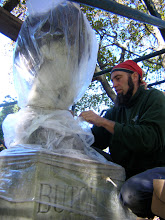It may be completely outnumbered by the much more frequent "Hey mate, where's the East/South chapel" from some dude who has stopped his car in the middle of the lane, often on a blind corner, and can't be bothered to get out and ask me politely... sometimes upwards of 6 times an hour when I'm close to the main road in the Jewish Old Ground... but that's a different story/rant....
I also love how the blue bags have been interpreted as art. There's a great art pic on the web featuring one of my bagging jobs... though I must admit that the jute string is so even that it may have been Grahame's job not mine... he's tends to be a bit neater with such things... and we were working in the Presbyterian old ground at Rookwood together...
http://www.flickr.com/photos/frontdrive34/7215330894/
The blue bags are not art. They may look like some Christo piece, but they're just there to help keep in moisture so that our lime mortar can set and cure effectively.
Lime mortar is wonderful stuff. It is the basis of historic buildings which have survived not just decades but centuries and often even millenia. The Romans were the first to really master and document its use... and the stuff that we are using, well, it's very much based on Roman practice. The only problem is that it requires more care than modern cements and glues.
We're using lime mortar for bedding joints and for the pointing of repaired fractures and cracks. Properly constructed, a good lime mortar will both stable and strong but remain just slightly weaker than the historic fabric it is used on. The mortar should also be slightly more permeable than the stone while also preventing water penetration: allowing the stone to breathe and dry out while still preventing rain or water from penetrating into the structure. Together, these factors should ensure that any future damage to the masonry will occur to the mortar and not to the historic stone. Likewise, weathering and soluble salt damage will be concentrated into the mortar (where the permeability makes it the zone of evaporation): sacrificially protecting the masonry from weathering and deterioration.
After Portland Cement was discovered and become inexpensive, it took over the building industry: it was so easy to use and required so little care and attention... in applying it, in mixing it, and while it set afterwards. Who cares that it leads to buildings with no flexibility, where cracks are permanent, where the stones and masonry fractures before the mortar, where water can flow in cracks but then not evaporate out... it's so easy to use and cleans up so quickly and sets so fast! It's all money. Short-term money... forget the long-term costs. Just look at the state of our buildings today: it looks like the Australian Standard (like the Canadian one) specifies that new buildings must not last longer than 20 years without wholesale replacement and structural work. It's like reinforced concrete... (I've got to be careful or I'll get onto another rant... why do we put vulnerable rusting metal inside concrete instead of building something that is inherently strong: do we want it to fail? Why is the Roman port of Ostia intact when we can't build something that will last 50 years?)
I guess then, the blue bags are a sign that some of us really do care... and are trying to keep some very good old traditions alive! Rookwood is such an amazing place... it's great to be having the opportunity to do some good work to contribute to its future.




No comments:
Post a Comment